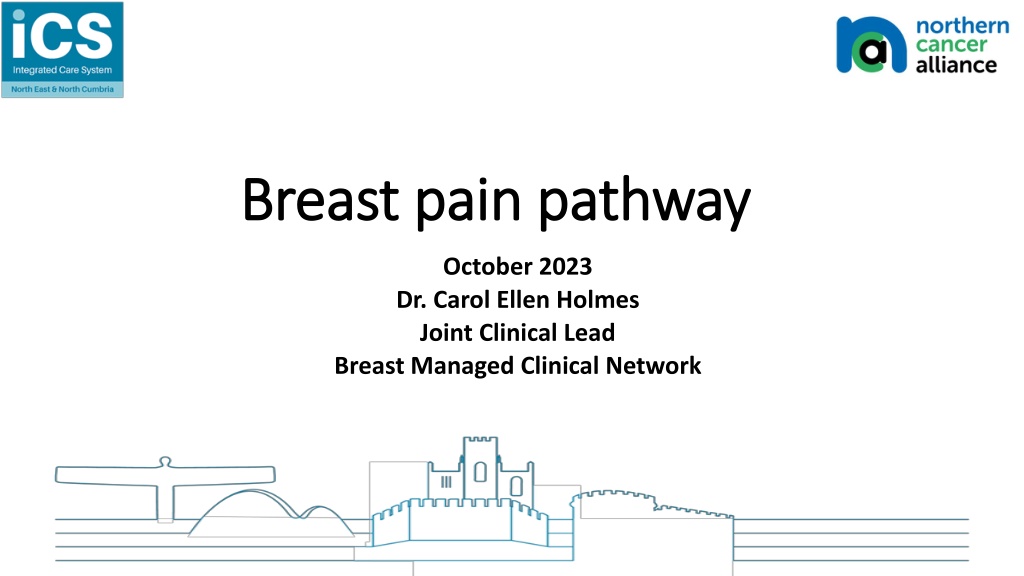Understanding Breast Pain and the Breast Pain Pathway
Breast pain, characterized by tenderness, throbbing, sharp, or burning sensations in the breast tissue, can affect individuals of all genders. This common symptom may vary in severity and frequency, and is typically not associated with cancer. The Breast Pain Pathway outlines the management of breast pain, emphasizing reassurance, watchful waiting, and appropriate referrals for further evaluation. By addressing concerns and streamlining the referral process, unnecessary imaging can be reduced, ensuring a better patient experience.
Download Presentation

Please find below an Image/Link to download the presentation.
The content on the website is provided AS IS for your information and personal use only. It may not be sold, licensed, or shared on other websites without obtaining consent from the author. Download presentation by click this link. If you encounter any issues during the download, it is possible that the publisher has removed the file from their server.
E N D
Presentation Transcript
Breast pain pathway Breast pain pathway October 2023 Dr. Carol Ellen Holmes Joint Clinical Lead Breast Managed Clinical Network
What is breast pain? What is breast pain? Breast pain can be described as tenderness, throbbing, sharp, stabbing, burning pain or tightness in the breast tissue. The pain may be constant or it may occur only occasionally, and it can occur in men, women and transgender people. Breast pain can range from mild to severe.
Background Background For many breast problems, especially in younger patients or patients presenting with breast pain only, reassurance and a period of watchful waiting may be suitable. Breast pain is not usually associated with cancer. It is a common symptom and, if of short duration with no other clinical concern, may be managed initially in a GP setting. Studies show that breast pain often settles with 3-6 months. Minor or moderate degree of breast pain with no lumps/bumps, when initial treatment fails and/or with unexplained persistent symptoms, greater than 3 months need to be referred onto the breast pain pathway. Cyclical breast pain in the younger patient does not need to be referred and can be managed supportively.
Why develop a Breast Pain Pathway? Where breast pain is the ONLY presenting breast symptom there is a very low level of cancer risk (less than for breast screening population, who have no symptoms) Currently there is variation in referral for women with breast pain (fast-track cancer referral, symptomatic pathway, other options) Where women are referred into secondary care they are often seen alongside women on a fast-track cancer pathway, raising anxiety for the women with breast pain only Has the potential to reduce unnecessary imaging whilst ensuring that these patients concerns are addressed (especially concerns about family history) Allows for better resource management of those waiting for investigation for breast cancer and better patient experience for those waiting for breast pain investigation only Excellent examples from elsewhere (East Mids and G Manchester)
Northern Cancer Alliance Approach Review of Breast Pain Pathway development Review of GP information, strategies/contacts for sharing the pathway Supporting development of Breast Pain Clinics across the region
Staged approach All areas can take up the primary care management once patient education and primary care education is in place Newcastle, Gateshead, North Tees and Northumbria deployed initially Other sites are being added as the local evidence base grows
Breast_pain_patient_leaflet_3.pdf (northerncanceralliance.nhs.uk) The leaflet was developed and tested with groups of people with a learning disability to ensure that the information is as accessible to as wide a health literacy range as possible
Breast-Cancer-Now_know_your_breasts.pdf (northerncanceralliance.nhs.uk)
Take home messages Breast Pain on its own has an extremely low risk of breast cancer. The breast pain pathway has been developed so that those ladies with breast pain only will get better support with their symptoms. This will mostly be provided in their GP practice. However if they are not responding they can be referred into a specific breast pain clinic. Anyone who is worried about their breast symptoms should see their GP.



























